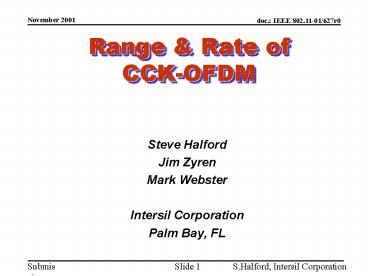Range PowerPoint PPT Presentation
Title: Range
1
Range Rate of CCK-OFDM
- Steve Halford
- Jim Zyren
- Mark Webster
- Intersil Corporation
- Palm Bay, FL
2
Does PBCC-22 add value to CCK-OFDM?
NO!
- Incomplete comparisons made in 11-01-477r1
- Ignores optional modes of CCK-OFDM (18 Mbps)
- Uses unexplained modes of PBCC (49 66 Mbps)
- Incorrect noise bandwidth values used in
11-01-286r1 - 11-01-286r1 Penalized OFDM by gt 7 dB
- Corrected in 11-01-286r2 but never presented
3
Range Calculations
For comparison -- only these values will differ
between CCK, OFDM, and PBCC
4
Path Loss Model
- Selected ITU-RP.1238 model
- See 802.15.2 Doc. 00-294r1 or 802.11 Doc.
11-01-339r0 - Model used by 11-01-286r2 assumes 8m of free
space propagation - Seems unreasonable for W-LAN environment
- Model selection has minor impact on conclusions
- Model
5
Range Equation Simplified
Distance (in m) as a function of SNR required to
meet a given packet error rate
6
SNR as a function of PER
Waveform Data Rate (Mbps) SNR per subcarrier (at MF output) in dB SNR per subcarrier (at MF output) in dB SNR per subcarrier (at MF output) in dB
SNR(.01) 1 PER SNR(.05) 5 PER SNR(.10) 10 PER
Barker 1 11.1 10.5 10.25
Barker 2 15.9 15.3 14.7
CCK 5.5 5.7 5.0 4.8
CCK 11 8.6 8.0 7.0
PBCC 5.5 1.9 1.5 1.2
PBCC 11 4.8 4.4 4.1
PBCC 22 9.0 8.5 8.3
OFDM 6 1.2 0.8 0.6
OFDM 9 3.8 3.4 3.1
OFDM 12 4.4 3.8 3.5
OFDM 18 7.0 6.4 6.1
OFDM 24 10.1 9.4 9.1
OFDM 36 13.1 12.7 12.4
OFDM 48 17.7 16.9 16.5
OFDM 54 19.0 18.3 18..0
7
Throughput Calculations
- Use Maximum Sustainable Throughput (Rmax) as
basis - Defined by 11-01-007 (see also 11-01-059)
- Consider the following case
- IEEE 802.11b short preamble with 1000 byte
packets - Acknowledgement packets of 14 bytes at same rate
as data - No access backoff (DIFS only between ACK
subsequent packets) - Modify the throughput to account for
re-transmissions - Same procedure as followed by 11-01-286r2
- Adjusts the throughput based on average of
retransmissions for a given - Same formula for all waveforms
8
Throughput with Re-transmission
Waveform Data Rate (Mbps) Throughput (Mbps) Throughput (Mbps) Throughput (Mbps) Throughput (Mbps)
Rmax R(0) 1 PER R(.01) 5 PER R(.05) 10 PER R(.10)
Barker 1 0.96 0.95 0.91 0.86
Barker 2 1.86 1.84 1.76 1.67
CCK/PBCC 5.5 4.63 4.59 4.40 4.17
CCK/PBCC 11 8.09 8.00 7.68 7.28
PBCC 22 12.89 12.76 12.24 11.60
OFDM 6 4.87 4.82 4.62 4.38
OFDM 9 6.69 6.62 6.35 6.02
OFDM 12 8.26 8.18 7.85 7.44
OFDM 18 10.75 10.65 10.22 9.68
OFDM 24 12.66 12.53 12.03 11.39
OFDM 36 15.50 15.35 14.73 13.95
OFDM 48 17.39 17.22 16.52 15.65
OFDM 54 18.02 17.84 17.11 16.22
9
TGg Range Rate for PER 0.05
Waveform Rate Range (meters) Throughput (Mbps)
CCK 11 35 7.5
PBCC 22 34 12.0
OFDM 18 35 10.0
OFDM 24 29 12.0
OFDM 36 23 14.5
OFDM 48 18 16.5
OFDM 54 16 17.0
10
TGg Range Rate for PER 0.05
In theory, a W-LAN system with PBCC-22 might get
2 Mbps higher throughput for this 5 meter region.
For all other regions, CCK-OFDM has equivalent
or superior throughput
11
Conclusions from Range vs. Rate
- CCK-OFDM offers superior throughput for nearly
all ranges - PBCC proposal offers a small throughput advantage
over a very limited range under ideal conditions - Optional 802.11a mode offers vastly superior
throughput for the 2.4 GHz band - Much better than the extended (gt22 Mbps) PBCC
- This is undisputed!
- See 11-01-339r0 11-01-286r2
- PBCC team recognized this advantage added the
same optional mode
12
Would adding PBCC-22 as Tx-only requirement make
sense?
- No!
- MAC issues
- How to handle broadcast?
- Market confusion due to adding a third waveform
- Violates the spirit of the PAR reqment for
single high rate waveform - No real throughput improvement in PBCC-22 mode
- Burden the standard with unnecessary IP
- Scramble sequence has no demonstrated value
- Questions remain about other codes with same
performance - Increased complexity to any TGg product
- Add gates ( IP) in order to transmit PBCC-22
- More modes to test and debug

